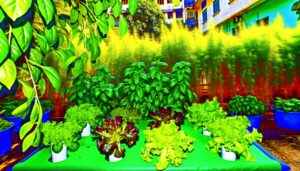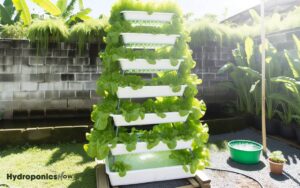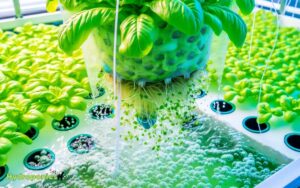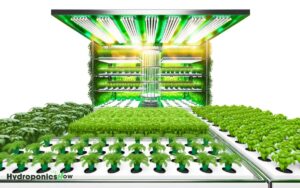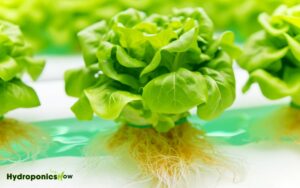Exploring Hydroponics Planting Methods in Rimworld: 3 Simple Steps
In RimWorld, hydroponic systems facilitate the cultivation of various plants, optimizing efficiency and yield by utilizing nutrient-rich water.
Setting up these systems involves maintaining controlled temperature and lighting conditions, ensuring ideal growth environments.
Suitable crop choices include rice, corn, and strawberries due to their high-yield potential. Nutrient management is crucial; maintaining pH levels between 5.5 and 6.5 and managing electrical conductivity are essential.
Backup power sources are advisable to guarantee continuous operation. Hydroponics also utilize up to 90% less water than traditional soil farming.
Efficient design and sustainability practices further enhance outcomes. Explore further for detailed setup and management strategies.
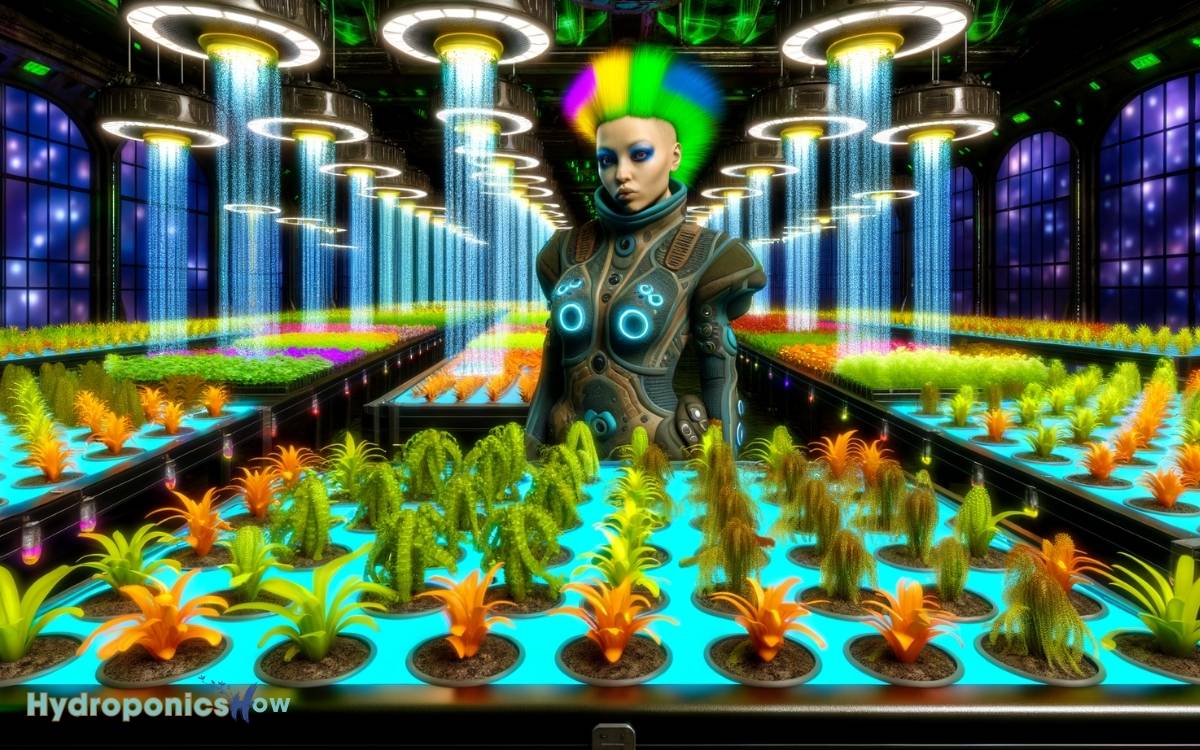
Key Takeaways
Understanding Hydroponics
Hydroponics, a method of growing plants without soil by using nutrient-rich water, offers a highly efficient and controlled agricultural system. This innovative technique allows for faster plant growth and higher yields by delivering essential nutrients directly to the roots. Interestingly, while hydroponics eliminates the need for traditional soil, some gardeners experiment with growing hydroponic tulips in soil to observe differences in growth patterns and adaptability. By carefully managing water, light, and nutrients, hydroponic systems provide a sustainable solution for year-round cultivation.
This technique leverages aqueous solutions enriched with essential minerals, facilitating ideal nutrient uptake by plant roots.
The absence of soil reduces the risk of soil-borne diseases and pests, minimizing the need for chemical pesticides.
Precision in nutrient delivery guarantees that plants receive a perfect balance of macro and micronutrients, promoting accelerated growth rates and higher yields.
Additionally, hydroponic systems afford significant water savings, as the closed-loop setups recycle water, reducing overall consumption.
Essentially, hydroponics enables the cultivation of crops in environments where traditional farming is impractical, offering a sustainable and scalable alternative to conventional agriculture.
Setting Up Hydroponic Basins
To harness the full potential of hydroponic systems, it is essential to understand the meticulous process of setting up hydroponic basins.
Begin by selecting a suitable indoor location with controlled temperature and lighting conditions. Guarantee the area is free from contaminants and has adequate ventilation.
Position the hydroponic basins equidistantly to optimize space and facilitate maintenance. Connect the basins to a reliable water supply system, incorporating a pump to ensure consistent nutrient circulation.
Install a drainage mechanism to prevent waterlogging and root rot. Use a pH meter to monitor and adjust the nutrient solution to maintain a pH level between 5.5 and 6.5.
Choosing the Right Crops
Selecting the appropriate crops for hydroponic cultivation in Rimworld necessitates a methodical evaluation of several key factors.
Primary considerations include the yield potential of various crops, their growth rates, and the efficiency with which they utilize available resources.
High-Yield Crop Choices
Ideal crop selection is important in maximizing yield efficiency in hydroponic systems within Rimworld.
To optimize productivity, players need to focus on crops that offer high yield per growth cycle, nutritional value, and utility within the colony. Selecting the right crops can greatly impact colony sustainability and resource management.
Consider the following crops for high-yield hydroponic farming:
- Rice: Fast growth and high yield, essential for quick food supplies.
- Corn: High nutritional value per plant, though slower to mature.
- Potatoes: Resilient and reliable, offering balanced yield and growth rates.
- Strawberries: Provides both food and mood boosts, enhancing colonist satisfaction.
- Cotton: Essential for textile production, supporting colony apparel and trade opportunities.
Growth Rate Considerations
When planning hydroponic farming in Rimworld, understanding the growth rates of various crops is important to achieving peak efficiency and ensuring a steady supply of resources for the colony.
Different crops exhibit varying growth rates, directly impacting the replenishment cycle and overall productivity.
Selecting the right crops can make a significant difference in resource management and food security.
| Crop Type | Growth Rate (Days) |
|---|---|
| Rice | 3 |
| Potatoes | 5 |
| Strawberries | 4.5 |
| Corn | 11 |
| Healroot | 7 |
Analyzing these growth rates allows players to strategically plan their planting schedules.
For instance, rice offers rapid growth, ideal for quick yields, while corn, despite its longer growth period, provides substantial harvests. Balancing these factors ensures efficient hydroponic operations.
Resource Efficiency Factors
Evaluating the resource efficiency of various crops in hydroponic systems is crucial for optimizing both yield and sustainability in Rimworld.
Each crop’s water, nutrient, and energy requirements must be meticulously analyzed to guarantee maximum productivity.
Factors like growth time, harvest yield, and resource consumption play pivotal roles in this assessment. Ideal crop choices can greatly impact colony sustainability and resource management.
Key considerations include:
- Growth Speed: Rapid-growing crops ensure quicker turnover and resource efficiency.
- Nutrient Demand: Crops with lower nutrient needs reduce overall resource expenditure.
- Water Use: Efficient water usage is essential in resource-scarce environments.
- Yield Per Plant: Higher yield per plant maximizes food production.
- Environmental Resilience: Crops tolerant to varying conditions ensure consistent output.
Understanding these factors assists in strategic crop selection for hydroponic systems in Rimworld.
Nutrient Management
Effective nutrient management is vital for optimizing plant growth in hydroponic systems within Rimworld.
Proper nutrient solutions must be carefully balanced to guarantee ideal pH levels and electrical conductivity (EC).
Ideal pH levels for most hydroponic crops range between 5.5 and 6.5, fostering efficient nutrient uptake.
Monitoring EC is essential as it indicates the concentration of nutrients; an EC too high or too low can stunt plant growth or lead to nutrient deficiencies.
Regular analysis and adjustments are necessary to maintain these parameters within the best range.
Additionally, periodic flushing of the hydroponic system can prevent the accumulation of salts and other residues, ensuring a stable nutrient environment for sustained plant health and productivity.
Dealing With Power Outages
Power outages present a formidable challenge to hydroponic systems in Rimworld. These interruptions can disrupt the crucial supply of water, nutrients, and light necessary for plant growth. To address this issue, several strategies can be implemented.
- Firstly, ensuring a reliable backup power source, such as batteries or generators, is key to maintaining system operations.
- Secondly, it is important to prioritize essential components to conserve energy during outages.
- Automated monitoring systems should be put in place to promptly detect and respond to power loss.
- Additionally, diversifying power sources by incorporating renewable options like solar panels can enhance system resilience.
- Lastly, establishing protocols for manual intervention during prolonged outages is essential to safeguard plants.
The frustration of losing entire crops, the stress of managing emergency scenarios, and the fear of long-term resource depletion all underscore the necessity for finding resilient solutions.
Despite these challenges, there is a determination among hydroponic system operators to overcome these obstacles, fueled by hope for future technological advancements.
Weather and Environmental Impact
Understanding the weather and environmental impact on hydroponic systems in Rimworld is essential for guaranteeing the continuous and ideal growth of plants, especially following power outages.
Variations in temperature, humidity, and light levels can greatly affect plant health and productivity.
Extreme weather events, such as cold snaps or heatwaves, pose additional risks by stressing the hydroponic system’s climate control mechanisms. It is vital to monitor and adjust these parameters to maintain ideal growing conditions.
| Weather Condition | Impact on Hydroponics |
|---|---|
| Cold Snaps | Reduced plant growth |
| Heatwaves | Overheating of systems |
| Heavy Rain | Potential flooding risks |
| Drought | Increased water usage |
| Storms | Power stability issues |
Careful management of these environmental factors ensures resilience and sustainability in hydroponic farming.
Efficiency Vs. Traditional Farming
Comparing the resource efficiency of hydroponic systems to traditional soil-based farming reveals notable differences in water and nutrient utilization.
Hydroponics typically uses up to 90% less water than soil farming by recycling water through a closed-loop system.
Nutrient delivery is also more precise, reducing waste and enhancing plant growth rates. Conversely, traditional farming often faces issues such as soil degradation and nutrient runoff, leading to inefficiencies.
- Water Conservation: Hydroponics uses noticeably less water.
- Nutrient Efficiency: Precise nutrient delivery minimizes waste.
- Growth Rate: Hydroponics can accelerate plant growth.
- Environmental Impact: Reduced soil degradation and runoff.
- Resource Management: Enhanced control over growing conditions.
These factors illustrate the superior efficiency of hydroponic systems in controlled environments.
Space Optimization
Space optimization in hydroponic farming within Rimworld necessitates efficient layout strategies to maximize growth potential.
By strategically arranging hydroponic basins and guaranteeing adequate spacing for plant health, one can achieve peak resource utilization.
This approach not only enhances yield but also promotes sustainability in constrained environments.
Efficient Layout Strategies
When designing hydroponic layouts in Rimworld, maximizing space efficiency is vital to ensuring peak resource utilization and productivity.
Effective layout strategies are essential to cultivating a robust and sustainable hydroponic farm within the spatial constraints of the game.
Key considerations include:
- Compact Design: Utilize every available tile to its fullest potential.
- Path Optimization: Guarantee colonists can move efficiently between hydroponic basins to reduce travel time.
- Symmetry: Maintain symmetry to simplify management and maintenance.
- Light Placement: Optimize light sources to cover the maximum number of hydroponic basins.
- Temperature Control: Ensure even temperature distribution to prevent crop loss.
Implementing these strategies enhances operational efficiency, thereby supporting sustained agricultural productivity and resource conservation in your Rimworld colony.
Maximizing Growth Potential
To maximize growth potential within hydroponic systems in Rimworld, it is essential to strategically allocate space to optimize both crop yield and resource efficiency.
Efficient space utilization involves placing hydroponic basins in a grid layout that minimizes wasted area while guaranteeing adequate access for colonists. Prioritize the placement of basins in well-lit, temperature-controlled environments to enhance growth rates.
Additionally, integrate irrigation and nutrient delivery systems to secure consistent water and nutrient supply. Employ automation for lighting and climate control to maintain ideal growing conditions without manual intervention.
Analyze the spatial arrangement periodically to identify and rectify inefficiencies. By meticulously planning and monitoring spatial allocation, one can greatly enhance productivity within the constrained environments of Rimworld hydroponic farming.
Long-term Sustainability
Ensuring long-term sustainability in hydroponic farming within Rimworld necessitates careful management of resources, energy efficiency, and continuous monitoring of plant health.
Effective strategies include optimizing nutrient solutions, implementing renewable energy sources, and maintaining a balanced ecosystem.
Key considerations involve:
- Resource Allocation: Efficient distribution and utilization of water and nutrients to prevent waste.
- Energy Management: Adoption of renewable energy sources like solar panels to power hydroponic systems.
- Plant Health Monitoring: Regular inspections and data analysis to promptly address any issues.
- Ecosystem Balance: Integrating beneficial insects and microorganisms to support plant health.
- Waste Reduction: Recycling and repurposing materials to minimize environmental impact.
Troubleshooting Common Issues
When managing hydroponics in Rimworld, one must address common issues such as nutrient solution imbalances and the control of light and temperature.
Nutrient imbalances can lead to stunted plant growth or disease, necessitating regular monitoring and adjustment.
Similarly, maintaining ideal light and temperature conditions is critical to ensuring healthy plant development and maximizing yield.
Nutrient Solution Imbalance
Nutrient solution balance in hydroponic systems can often lead to stunted plant growth, nutrient deficiencies, and overall poor crop yields. The perfect balance of nutrients is crucial for excellent plant health. Monitoring and adjusting the nutrient solution is essential to mitigate these issues.
Common symptoms of nutrient balance include:
- Chlorosis: Yellowing of leaves due to lack of essential elements like nitrogen or iron.
- Necrosis: Browning, dying tissue indicating severe nutrient deficiencies.
- Stunted Growth: Poor development due to insufficient or excess nutrients.
- Root Rot: Over-saturation or incorrect pH levels causing root damage.
- Leaf Curling: Deformation of leaves often due to micronutrient imbalances.
Light and Temperature Control
Consistently maintaining ideal light intensity and temperature is crucial for the successful operation of hydroponic systems in Rimworld.
Light intensity should be optimized to simulate natural sunlight, typically achieved using sun lamps. Inadequate light can stunt plant growth, while excessive light can cause overheating or energy inefficiency.
Temperature regulation is equally essential; the recommended range is between 21°C and 26°C. Deviations can lead to thermal stress, affecting nutrient uptake and growth rates.
Common issues include fluctuating power supplies, leading to inconsistent lighting, and inadequate insulation causing temperature instability.
Monitoring systems and automated controls can mitigate these problems, ensuring a stable environment conducive to plant health and productivity. Regular maintenance is key to preempting and addressing these challenges effectively.
Conclusion
To conclude, hydroponics in RimWorld offers a highly efficient and sustainable agricultural method, akin to a well-oiled machine.
By meticulously managing nutrient levels, optimizing space, and preparing for potential power outages, players can maximize crop yield and resilience.
Compared to traditional farming, hydroponics provides superior efficiency and adaptability, making it an invaluable technique for long-term survival.
Proper setup and troubleshooting guarantee that hydroponic systems remain a reliable food source in the dynamic environment of RimWorld.

